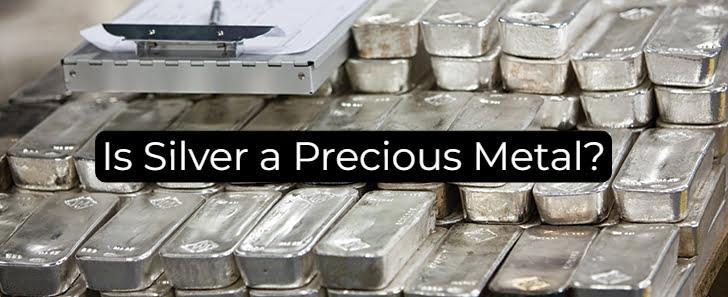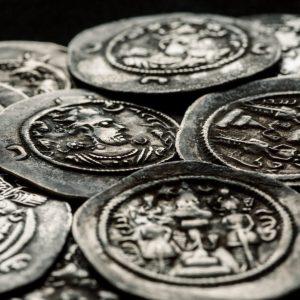
Is silver a precious metal or not? Silver was one of the most well-known metals in history for producing jewelry, tableware, and currency.
Pendants, wrist links, chains, body jewelry, and belt buckles made of sterling silver (which typically contains 92.5% silver and 7.5% copper) are popular accessories even now.
Due to the turn of the decade, silver particles and their derivatives have found applications as water source filters, pharmaceuticals, wellness instruments, electricity conductors, powered contacts, catalyst assistance, gadgets, glasses, chemical equipment, pictures, and welding alloys.
Silver (Ag) is a bright, shiny metal highly valued for its ability to conduct electricity and other general qualities. It is highly reflective and has a high heat conductivity.
Silver is extracted from ores that include argentite (Ag2S) and horn silver (AgCl), often mined with copper, lead, or gold.
In the periodic chart, silver may be found in Group 11 (Ib) of Period 5. Its chemical characteristics are intermediate between Gold (Period 6) and Copper (Period 4).
While precious metals such as gold tend to get more attention, silver has some attractive qualities.
Silver’s Numerous Benefits

Silver’s relevance as an investment is supported by its long-term historical viewpoint and the complexities of the present market. Silver’s price rises throughout time have protected its purchasing power against inflation. For this reason, it is sometimes called an “inflation hedge” among professionals in the financial sector.
Advantages of Silver:
- Reflectivity is relatively high for silver.
- Silver may be refined to a dazzling gloss.
- It is affordable in comparison to platinum and gold.
- The properties of silver include being soft, malleable, and ductile.
- Silver’s antimicrobial characteristics make it ideal for use in kitchenware.
- When contrasted with other alloys and costume jewelry, silver lasts far longer due to its durability.
All of this points to the fact that silver’s worth is based on its ability to maintain buying power. Its allure is more like that of long-term savings than of short-term gambling.
One such perk is silver’s relative ease of exchange. A commodity’s liquidity indicates how fast and readily it may be sold without significantly affecting its price. Having money set up for a “rainy day” or crisis might be a lifesaver in the case of a market crash or other unforeseen setback.
Although it’s hard to know the future, silver investing has minimal risk.
The History of Silver

Silver was first deposited into the earth’s crust by asteroids that flew by billions of years ago. Compounds of silver with copper or gold are common. This means that roughly half of all silver generated nowadays is a byproduct of refining other ores.
Since its discovery in Turkey approximately five thousand years ago, silver has been highly prized by cultures worldwide. Silver’s high market value has led to its incorporation into various products, including jewelry, flatware, sculptures, and even ceremonial implements. Silver thread was employed for fabric embroidery and as a plating on weapons, armor, furniture, and metal containers.
Silver, however, has many more uses than only as a decorative metal. Throughout the Ancient Greeks, silver remained the precious metal of choice for coinage.
The initial Athenian tetradrachm, a big silver coin intended to pay the weekly salary of a skilled worker or warrior, was produced in the sixth century BCE. It became the first coin to see widespread circulation, and it quickly gained acceptance beyond Greece’s boundaries to become the world’s prehistoric standard currency.
widespread circulation, and it quickly gained acceptance beyond Greece’s boundaries to become the world’s prehistoric standard currency.
At about the same time, people learned that silver might kill germs. Silver bottles were used to keep alcoholic beverages to avoid spoilage. Silver’s medicinal advantages and antimicrobial characteristics were first documented by Hippocrates, the “father of medicine,” approximately 400 BC.
Arguably, the most significant innovation of the modern era, photography, relied on silver in its early stages. Historically, silver emulsion was used to generate the photosensitive film utilized for black-and-white pictures.
Silver’s higher reflecting characteristics allowed for silver-coated cloth panels to be used in the early days of cinema, allowing for a brighter and clearer projection. The movie business and the glitz of Hollywood have been associated with the phrase “silver screen” for decades.
Why Silver is Important Today

Even now, silver is indispensable in many fields of study and modern technologies.
Electronics: Silver’s high conductivity makes it ideal for plating circuit board connections. Almost all smartphones, computers, automobiles, and gadgets include silver. It is crucial to efforts to promote renewable energy because of its high conductivity and high reflectivity, which increase the productivity of solar panels.
Vehicles: In the automobile industry, silver is utilized for various functions, from electrical controls and detectors to plugs. Its distinct physical and chemical features make it a valuable resource for renewable energy applications like hydrogen fuel cells and electric car battery manufacturing. Silver improves the batteries’ effectiveness and reliability, increasing their capacity to store energy and your driving distance.
Medicine: The application of silver in burn creams and ulcer dressings is based on Hippocrates’s first findings in medicine. Antimicrobial silver nanoparticles disrupt the cellular membranes of bacteria as well as other pathogens, therefore stopping their ability to reproduce. Antibiotic-resistant bacteria have prompted scientists to look once again to silver for the prevention and treatment of diseases.
Target Markets of Silver
- United Kingdom: The UK jewelry industry is dominated by selling precious metals like silver and gold. The overall value of the market is over £4.74 billion. The precious metals may be certified since proper processes and rules are in place. The UK Jewelry Market, 2017-2022 analysis predicts that the jewelry industry in the United Kingdom will expand over £685m over the following five years.
- United States: The jewelry industry in the U.S. is ranked as the largest in the world. The jewelry industry in the United States has expanded steadily over the last several years, and experts predict even more growth between 2020 and 2024. Increases in disposable income, online shopping, urbanization, and the percentage of women in the population all play a role in the booming state of the U.S. jewelry industry.
Why People Invest in Silver
Silver has been widely employed as a payment and a storage of wealth for ages. Silver has been used as a portfolio diversifier because of its perceived value since the beginning. Silver, in contrast to more common metals like iron and copper, exists in only trace amounts in the Earth’s crust. The value of silver usually corresponds strongly to industrial demand.
While silver’s price fluctuations have traditionally also been strongly tied to that of gold, assessments reveal the metal’s previous effectiveness has been similar to conventional financial assets such as equities, bonds, and various commodities. Many people look towards investing in precious metals IRA companies to diversify their portfolios during inflation.

